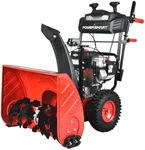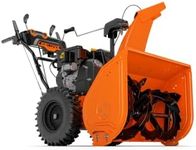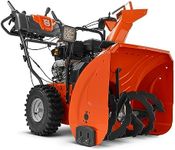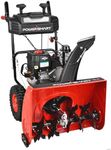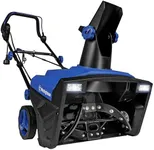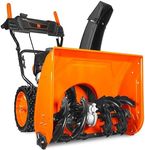Buying Guide for the Best Electric Start Snow Blower
Choosing the right electric-start snow blower can make a significant difference in how easily and efficiently you can clear snow from your driveway, sidewalks, and other areas. When selecting a snow blower, it's important to consider various specifications that will determine its performance, ease of use, and suitability for your specific needs. Understanding these key specs will help you make an informed decision and ensure you get the best fit for your snow removal requirements.Clearing WidthThe clearing width of a snow blower refers to the width of the path it can clear in a single pass. This spec is important because it determines how quickly you can clear a given area. Snow blowers with a wider clearing width can clear large areas more quickly, but they may be harder to maneuver in tight spaces. For small driveways and walkways, a clearing width of 18-22 inches is usually sufficient. For larger areas, consider a clearing width of 24 inches or more. Choose a clearing width that matches the size of the area you need to clear and your ability to handle the machine.
Intake HeightThe intake height is the maximum height of snow that the snow blower can handle in one pass. This spec is crucial for areas that experience heavy snowfall. A higher intake height allows the snow blower to handle deeper snow without clogging or requiring multiple passes. For regions with light to moderate snowfall, an intake height of 12-18 inches is typically adequate. For areas with heavy snowfall, look for an intake height of 20 inches or more. Consider the typical snowfall in your area to determine the appropriate intake height for your needs.
Engine PowerEngine power, measured in horsepower (HP) or cubic centimeters (cc), indicates the strength of the snow blower's engine. This spec is important because it affects the machine's ability to handle heavy, wet snow and its overall performance. More powerful engines can handle tougher conditions and larger areas more efficiently. For light to moderate snowfall, an engine with 5-7 HP or 150-200 cc is usually sufficient. For heavy snowfall and larger areas, consider an engine with 8 HP or more, or 250 cc and above. Choose an engine power that matches the typical snow conditions and the size of the area you need to clear.
Electric StartThe electric start feature allows you to start the snow blower with the push of a button, rather than using a manual pull-start. This spec is important for ease of use, especially in cold weather when engines can be harder to start. Electric start is particularly beneficial for those who may have difficulty with manual pull-starts, such as older adults or individuals with physical limitations. Most modern snow blowers come with this feature, but it's always good to confirm. If convenience and ease of use are priorities for you, make sure the snow blower has an electric start.
Auger TypeThe auger is the part of the snow blower that scoops up the snow and feeds it into the chute. There are two main types of augers: single-stage and two-stage. Single-stage augers are suitable for light to moderate snowfall and are typically found in smaller, more compact snow blowers. They are ideal for paved surfaces. Two-stage augers are more powerful and can handle heavier, wetter snow and larger areas. They are better suited for gravel or uneven surfaces. Choose the auger type based on the typical snow conditions and the surface you will be clearing.
Chute ControlChute control refers to the mechanism that allows you to direct where the snow is thrown. This spec is important for efficiently managing where the cleared snow is deposited. There are manual and remote chute controls. Manual chute controls require you to adjust the direction by hand, which can be less convenient. Remote chute controls allow you to adjust the direction from the operator's position, making it easier to use. If you need to frequently change the direction of the snow discharge, a remote chute control can be very beneficial. Consider how often you will need to adjust the chute direction when choosing this feature.
